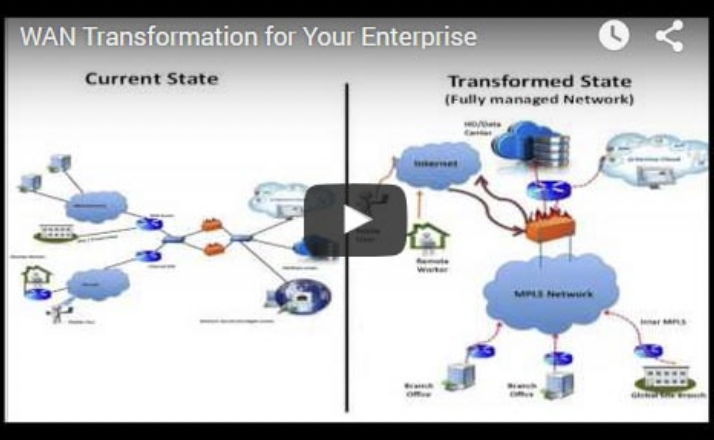WAN Transformation for Your Enterprise
SPEAKERS:
Daniel Alex, President – Telecom Business, Sify Technologies Ltd
DATE:
Thursday, August 13, 2015
DESCRIPTION:
Organizations need to move from using widely disparate and hybrid networks to integrated cloud-enabled networking platforms that can provide seamless manageability, high performance and high degrees of resilience and security. In this insightful webinar you will learn how to justify the transformation to stakeholders and plan for the transformation.
What is driving businesses to consider WAN Transformation?
Today’s hyper-connected and hyper-competitive marketplace needs enterprises that can react quickly and efficiently to the changing market scenarios. To respond with speed to these new market expectations, businesses need 24×7 access to reliable and high-performance connectivity. From connecting employees spread across geographies to responding and engaging with customers –a high performance and secure Enterprise WAN is an essential tool for business success.
The emergence of cloud technologies has created an urgent need for companies to reassess their current Wide Area Network (WAN) infrastructures and it has become clear that to power their future growth, they need to invest NOW in the next generation of Enterprise WAN. Instead of the usual add-on WAN optimization and acceleration solutions, enterprises must undertake to transform their WAN ecosystem from the bottom up – turning it into an integrated, cloud-enabled networking platform.
To understand the fundamentals of WAN transformation you can read our first blog part of our more detailed WAN transformation series.
Over the last few years, while servicing its various clients Sify has acquired a deep understanding of the networking problems, bottlenecks, and requirements of enterprises across all industries. This feedback and understanding prompted Sify to create WAN Transformation services.
What are these business needs driving WAN transformation?
Organizations are continuously dealing with several pressing problems and challenges with their network services; in the long term, some of these issues can severely limit business growth.
Operational complexity – resulting from the need to manage hundreds, or in some cases thousands, of sites and dealing with multiple service providers for non-converged voice and data networks.
Managing infrastructure costs – spiraling CAPEX and OPEX costs while ramping up or down. Businesses are looking for an overall reduction of costs by integrating disparate networks.
Technology Obsolescence – Need to keep pace with technology innovation while eliminating the risk of investing in old or dying technology.
Enhancing Network Security –urgent need for a holistic and unified security system to plug all security issues due to overlapping networks and multiple providers.
Administrative challenges –managing multiple vendors with separate contracts and SLAs takes up enormous amounts of time and effort.
Enterprise WAN systems are expected to deliver a vast number of services and support new technologies and trends. The scope of the network services must increase to deal with various factors such as – Data Center virtualization, growing demand for the virtual workplace, the rise of BOYD culture, stringent business compliance and the need for faster, secure and reliable communication platforms. To manage the resulting complicated networking scenarios and infrastructure challenges, CIOs need to carefully consider WAN Transformation.
As the most successful Enterprise WAN service provider in the country, we understand what businesses need from their WANs. We offer services that range from the Data Center, network, cloud, application, and technology integration. Our decades of experience in building and managing complex network environments along with our network integration services make us the perfect partners for your WAN transformation journey.
Enterprise WAN: The past and the future
WAN – Wide Area Network, the three magic words that connect our world. Simply put, WAN is the network that connects local areas spread across the world.
The word network might conjure visions of tangled cables and blinking routers, but we have come a long way from the days when a 9.6 Kbps line was considered fast! Since its inception in the 1970s, WAN has been responsible for connecting people and facilitating business.
We trace the WAN journey through all its technological leaps from the 1970s to the present day and take a quick peek into the future of Enterprise WAN.
WAN evolution – 1970s to the present day
The late 1970s saw, what could be called, the start of WAN with X.25 Networks – a popular option with the maximum speed of 9.6 Kbps, which was used by many companies at that time.
The 1980s saw considerable innovations in WAN technology and through the decade network speeds of leased point-to-point lines kept improving. 1987 saw Cisco introducing routers to replace remote bridges.
At the beginning of 1990s, frame relay service was introduced and revolutionized the enterprise WAN industry by drastically reducing costs and increasing operational efficiency. In less than a decade, even the most reluctant organizations were using the technology.
The next big leap came with MPLS (Multiprotocol Label Switching) – a successor to Frame Relay. Since its launch in early 2000s, it has been widely adopted by the majority of enterprises. It provides an IP based service to deliver voice, data and video on one network. Over time,WAN optimization technology has been added to MPLS networks to squeeze out more bandwidth and lower costs.
Enterprise WAN in the coming decade
Plagued by performance and reliability issues, WAN technology could not get the desired flexibility and cost effectiveness that other Internet based services achieved.
Cloud computing platforms changed this. SD- WAN (Software Defined-WAN) is the technology which will be the foundation of the next generation of enterprise WAN. It is software controlled, virtualized Network delivered through the cloud; with all the cloud related benefits of scalability, cost effectiveness and fast deployment.
Now that cloud service providers are offering cloud aligned network solutions, organizations can finally get access to the next generation of WAN to keep pace with cloud-based application.
Organizations need to move from using widely disparate and hybrid networks to integrated cloud-enabled networking platforms that can provide seamless manageability, high performance and high degrees of resilience and security. Watch this insightful video on WAN transformation




























































